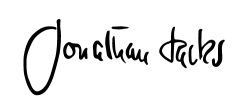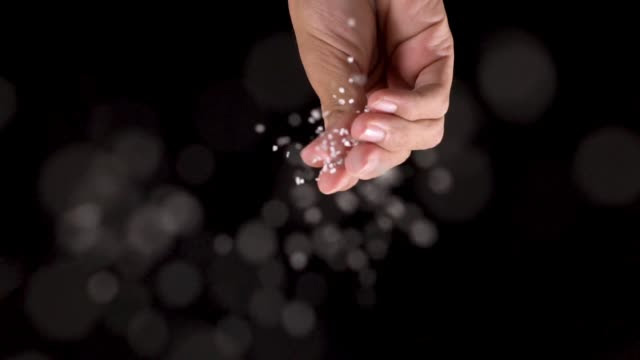
Slow motion with center composition: Sprinkling salt on top of camera view with copy space and black background.
Jonathan Sacks – Kohelet, Tolstoy and the Red Heifer
The command of the parah adumah, the Red Heifer, with which our parsha begins, is known as the hardest of the mitzvot to understand. The opening words, zot chukat ha-Torah, are taken to mean, this is the supreme example of a chok in the Torah, that is, a law whose logic is obscure, perhaps unfathomable.
It was a ritual for the purification of those who had been in contact with, or in, certain forms of proximity to a dead body. A dead body is the primary source of impurity, and the defilement it caused to the living meant that the person so affected could not enter the precincts of the Tabernacle or Temple until cleansed, in a process that lasted seven days.
A key element of the purification process involved a Priest sprinkling the person so affected, on the third and seventh day, with a specially prepared liquid known as “the water of cleansing.” First a Red Heifer had to be found, without a blemish, and which had never been used to perform work: a yoke had never been placed on it. This was ritually killed and burned outside the camp. Cedar wood, hyssop, and scarlet wool were added to the fire, and the ashes placed in a vessel containing “living” i.e. fresh water. It was this that was sprinkled on those who had become impure by contact with death. One of the more paradoxical features of the rite is that though it cleansed the impure, it rendered impure those who were involved with the preparation of the water of cleansing.
Though the ritual has not been practised since the days of the Temple, it nonetheless remains significant, in itself and for an understanding of what a chok, usually translated as “statute,” actually is. Other instances include the prohibition against eating meat and milk together, wearing clothes of mixed wool and linen (shatnez) and sowing a field with two kinds of grain (kilayim). There have been several very different explanations of chukim.
The most famous is that a chok is a law whose logic we cannot understand. It makes sense to God, but it makes no sense to us. We cannot aspire to the kind of cosmic wisdom that would allow us to see its point and purpose. Or perhaps, as Rav Saadia Gaon put it, it is a command issued for no other reason than to reward us for obeying it.[1]
The Sages recognised that whereas Gentiles might understand Jewish laws based on social justice (mishpatim) or historical memory (edot), commands such as the prohibition of eating meat and milk together seemed irrational and superstitious. The chukim were laws of which “Satan and the nations of the world made fun.”[2]
Maimonides had a quite different view. He believed that no Divine command was irrational. To suppose otherwise was to think God inferior to human beings. The chukim only appear to be inexplicable because we have forgotten the original context in which they were ordained. Each of them was a rejection of, and education against, some idolatrous practice. For the most part, however, such practises have died out, which is why we now find the commands hard to understand.[3]
A third view, adopted by Nahmanides in the thirteenth century[4] and further articulated by Samson Raphael Hirsch in the nineteenth, is that the chukim were laws designed to teach the integrity of nature. Nature has its own laws, domains and boundaries, to cross which is to dishonour the divinely created order, and to threaten nature itself. So we do not combine animal (wool) and vegetable (linen) textiles, or mix animal life (milk) and animal death (meat). As for the Red Heifer, Hirsch says that the ritual is to cleanse humans from depression brought about by reminders of human mortality.
My own view is that chukim are commands deliberately intended to bypass the rational brain, the pre-frontal cortex. The root from which the word chok comes is h-k-k, meaning, “to engrave.” Writing is on the surface; engraving cuts much deeper than the surface. Rituals go deep below the surface of the mind, and for an important reason. We are not fully rational animals, and we can make momentous mistakes if we think we are. We have a limbic system, an emotional brain. We also have an extremely powerful set of reactions to potential danger, located in the amygdala, that lead us to flee, freeze or fight. A moral system, to be adequate to the human condition, must recognise the nature of the human condition. It must speak to our fears.
The most profound fear most of us have is of death. As La Rochefoucauld said, “Neither the sun nor death can be looked on with a steady eye.” Few have explored death and the tragic shadow it casts over life more profoundly than the author of Kohelet (Ecclesiastes):
“The fate of man is the fate of cattle; the same fate awaits them both, the death of one is like the death of the other, their spirits are the same, and the pre-eminence of man over beast is nothing, for it is all shallow breath. All end in the same place; all emerge from dust and all go back to dust” (Eccl. 3:19-20).
The knowledge that he will die robs Kohelet of any sense of the meaningfulness of life. We have no idea what will happen, after our death, to what we have achieved in life. Death makes mockery of virtue: the hero may die young while the coward lives to old age. And bereavement is tragic in a different way. To lose those we love is to have the fabric of our life torn, perhaps irreparably. Death defiles in the simplest, starkest sense: mortality opens an abyss between us and God’s eternity.
It is this fear, existential and elemental, to which the rite of the Heifer is addressed. The animal itself is the starkest symbol of pure, animal life, untamed, undomesticated. The red, like the scarlet of the wool, is the colour of blood, the essence of life. The cedar, tallest of trees, represents vegetative life. The hyssop symbolises purity. All these were reduced to ash in the fire, a powerful drama of mortality. The ash itself was then dissolved in water, symbolising continuity, the flow of life, and the potential of rebirth. The body dies but the spirit flows on. A generation dies but another is born. Lives may end but life does not. Those who live after us continue what we began, and we live on in them. Life is a never-ending stream, and a trace of us is carried onward to the future.
The person in modern times who most deeply experienced and expressed what Kohelet felt was Tolstoy, who told the story in his essay, A Confession.[5] By the time he wrote it, in his early fifties, he had already published two of the greatest novels ever written, War and Peace and Anna Karenina. His literary legacy was secure. His greatness was universally recognised. He was married, with children. He had a large estate. His health was good. Yet he was overcome with a sense of the meaninglessness of life in the face of the knowledge that we will all die. He quoted Kohelet at length. He contemplated suicide. The question that haunted him was: “Is there any meaning in my life that will not be annihilated by the inevitability of death which awaits me?”[6]
He searched for an answer in science, but all it told him was that “in the infinity of space and the infinity of time infinitely small particles mutate with infinite complexity.” Science deals in causes and effects, not purpose and meaning. In the end, he concluded that only religious faith rescues life from meaninglessness. “Rational knowledge, as presented by the learned and wise, negates the meaning of life.”[7] What is needed is something other than rational knowledge. “Faith is the force of life. If a man lives, then he must believe in something … If he does understand the illusion of the finite, he is bound to believe in the infinite. Without faith it is impossible to live.”[8]
That is why, to defeat the defilement of contact with death, there must be a ritual that bypasses rational knowledge. Hence the rite of the Red Heifer, in which death is dissolved in the waters of life, and those on whom it is sprinkled are made pure again so that they can enter the precincts of the Shechinah and re-establish contact with eternity.
We no longer have the Red Heifer and its seven-day purification ritual, but we do have the shiva, the seven days of mourning during which we are comforted by others and thus reconnected with life. Our grief is gradually dissolved by the contact with friends and family, as the ashes of the Heifer were dissolved in the “living water.” We emerge, still bereaved, but in some measure cleansed, purified, able again to face life.
I believe that we can emerge from the shadow of death if we allow ourselves to be healed by the God of life. To do so, though, we need the help of others. “A prisoner cannot release himself from prison,”[9] says the Talmud. It took a Kohen to sprinkle the waters of cleansing. It takes comforters to lift our grief. But faith – faith from the world of chok, deeper than the rational mind – can help cure our deepest fears.
Shabbat Shalom

[1] Saadia Gaon, Beliefs and Opinions, Book III.
[2] Yoma 67b.
[3] The Guide for the Perplexed, III:31.
[4] Commentary to Leviticus 19:19.
[5] Leo Tolstoy, A Confession and Other Religious Writings, Penguin Classics, 1987.
[6] Ibid., 35.
[7] Ibid., 50.
[8] Ibid., 54.
[9] Brachot 5b.







